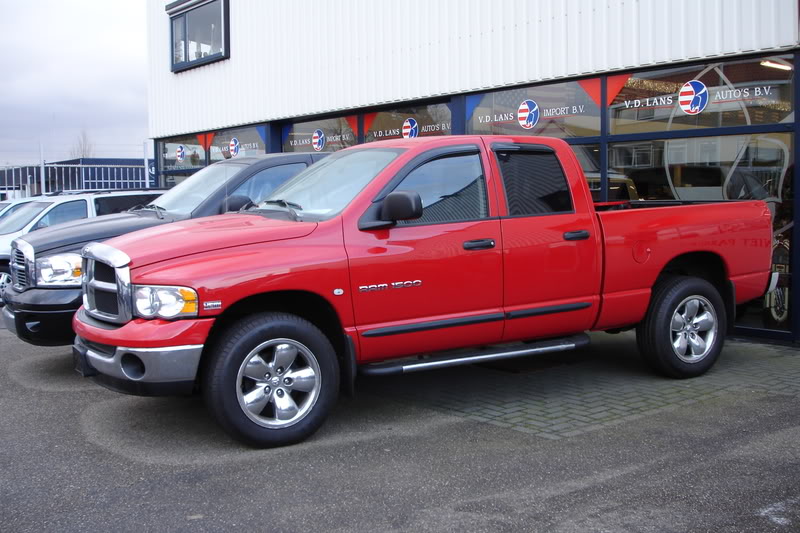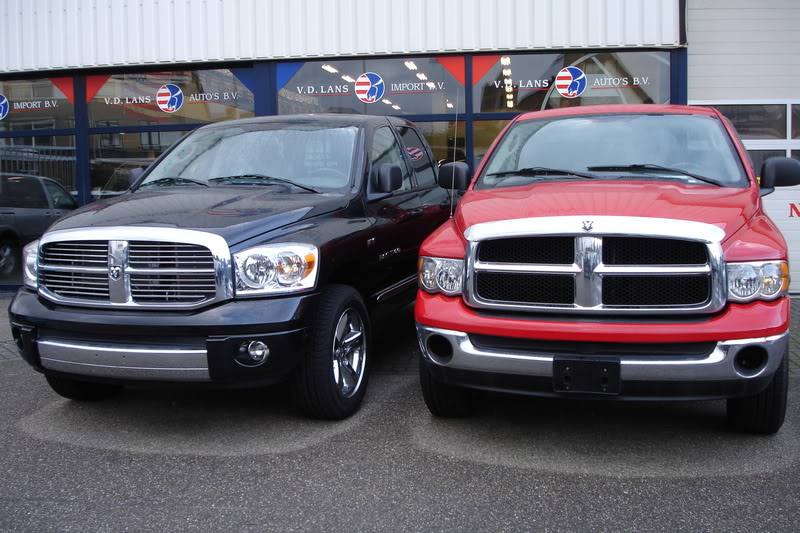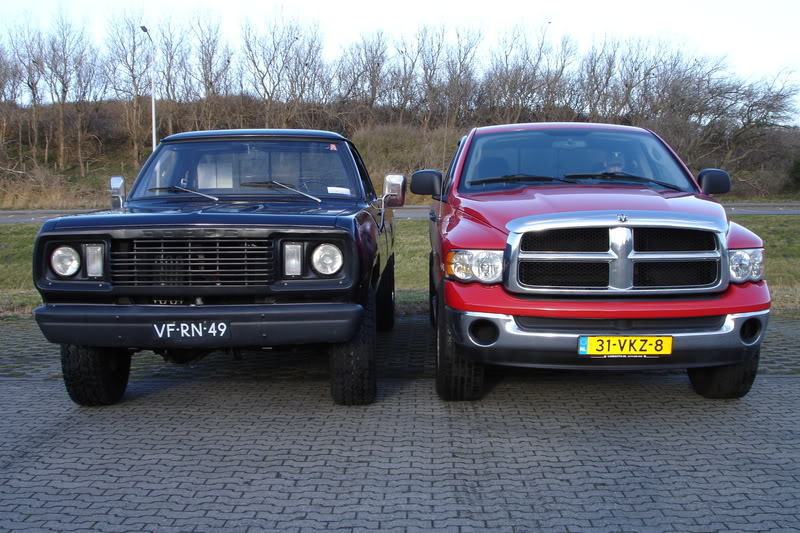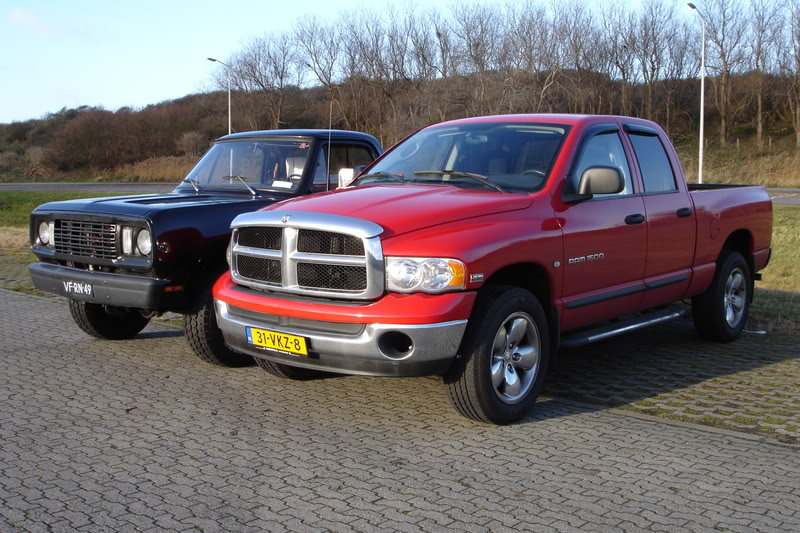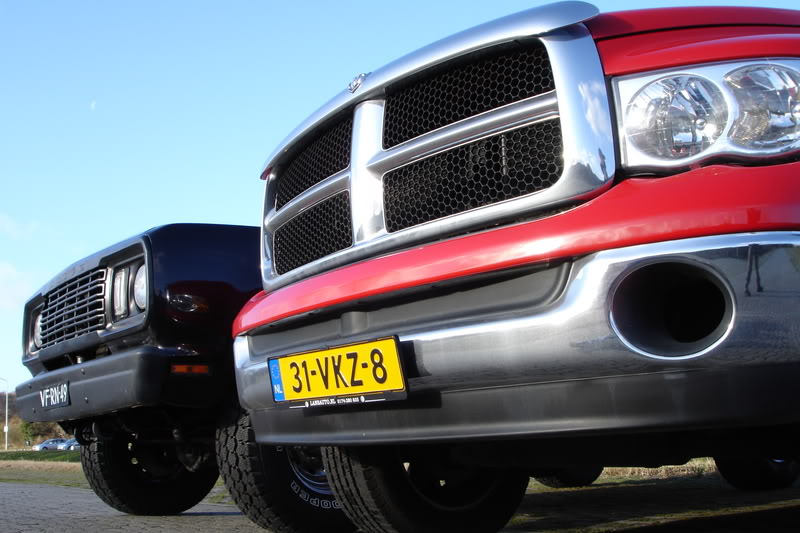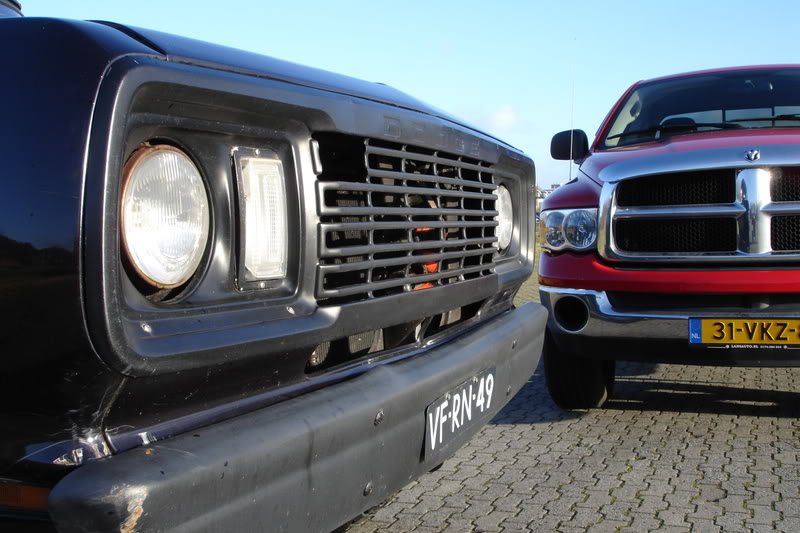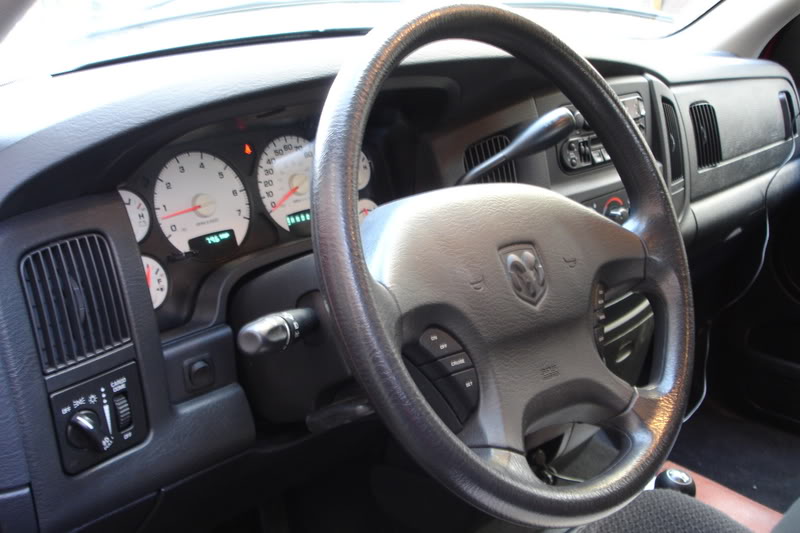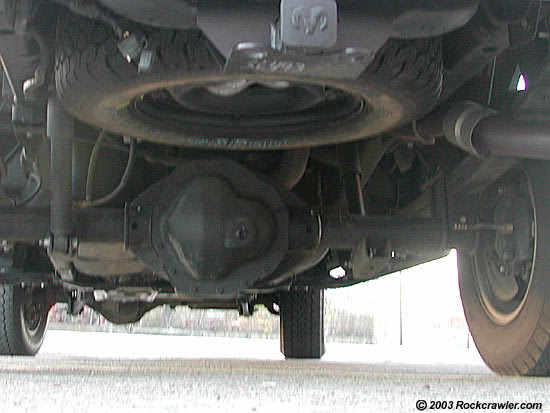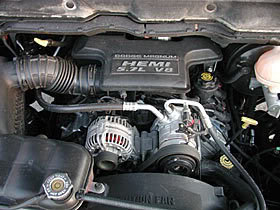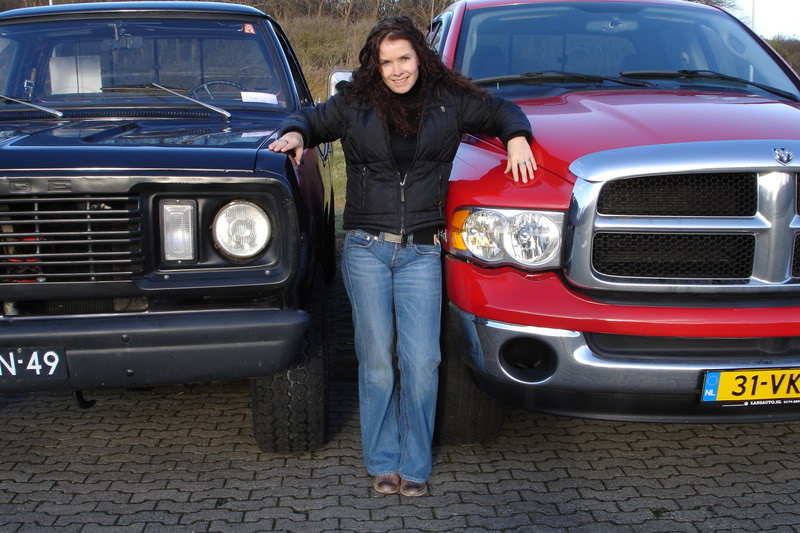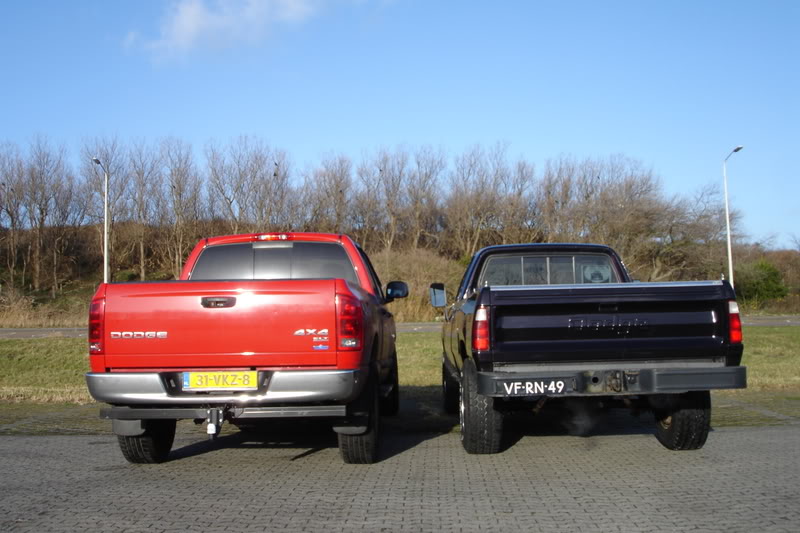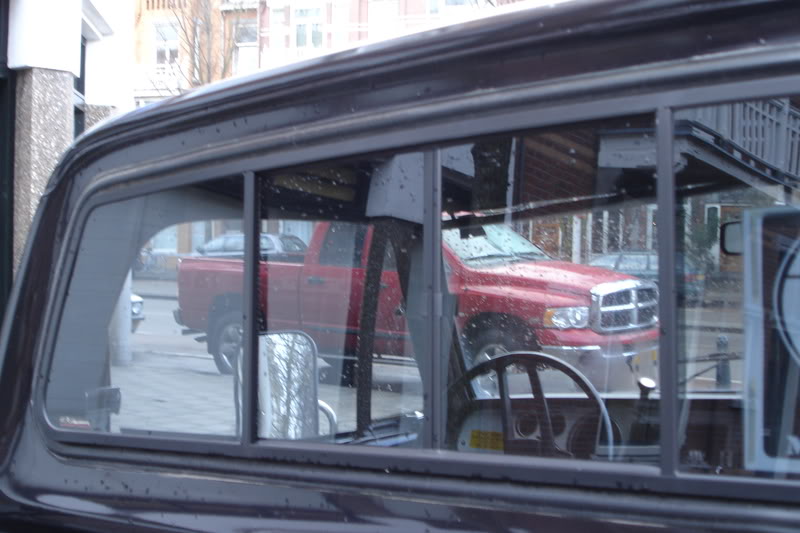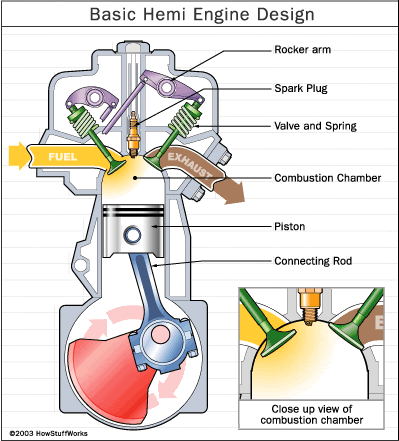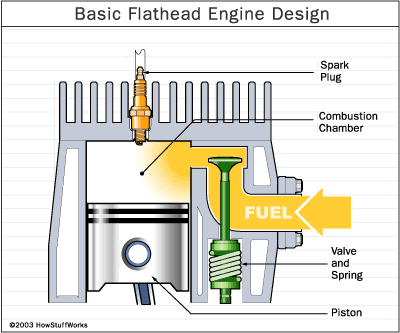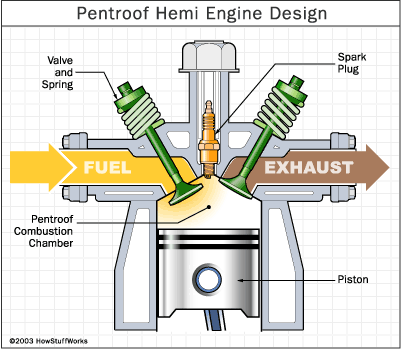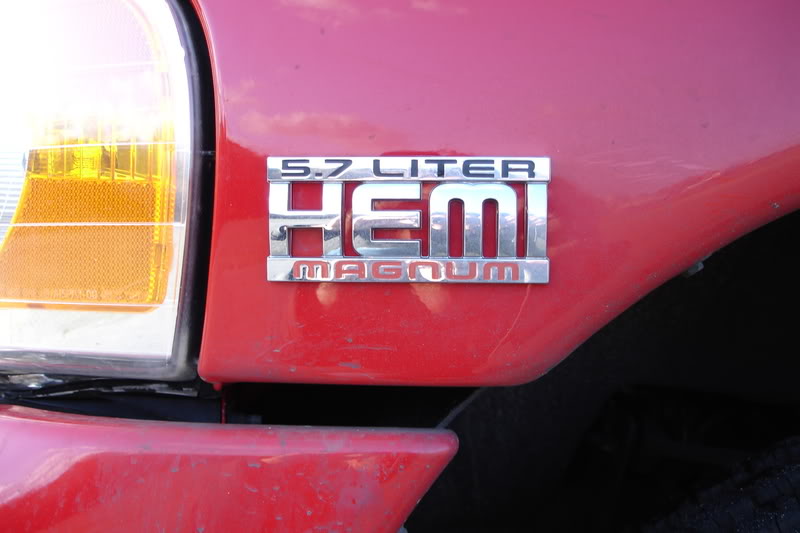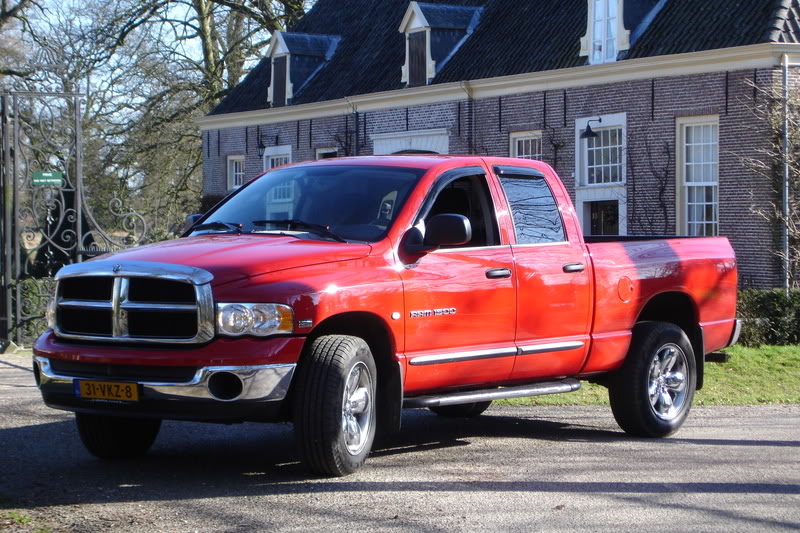We hebben een Dodge Hemi pickup …
… als leenauto. Cees heeft zijn GMC verkocht en in januari 2008 komt zijn nieuwe auto op kenteken en tot die tijd krijgen we een leenauto mee. Ted van der Lans vraagt aan Cees, wat hij mee wil hebben. Hij heeft een aantal auto’s staan die in aanmerking komen zoals een Skoda, Transsit busje en enkele Chevy’s. Cees weet het niet. Ik mocht kiezen, wel heb je ooit! Waar maak je dat mee? Ik waan me in de zevende hemel en ik zeg: “Doe mij die rooie maar…”.
Zo gezegd, zo gedaan. Ted van der Lans wees hem zelf overigens ook al aan, want hij weet dat ik gek ben op mopars! Deze Dodge is splinternieuw binnengekomen en moet nog op kenteken gezet worden. Zodoende was het nog even drie dagen wachten, maar nu rijden we erin.
Woensdagavond ging mijn fiets stuk, die brak zowat in twee stukken … Wat een toeval, zeg, kon donderdagochtend meteen Dodge meenemen naar mijn werk!!! WOW!!! En, nee…, ik heb de fiets niet gesaboteerd…!
Meteen maken we een mooie fotosessie met deze HEMI Dodge en mijn W200. Een fotogeniek duo…
Een Dodge met een overdosis Dodge-genen.
We gaan met onze testwagen een weekend naar Duitsland. Helaas is er in de Dodge nog GEEN gas ingebouwd. Auw! Hoeveel je precies verbruikt, is natuurlijk ook afhankelijk van de rijstijl.
De Ram oogt van alle zijden zeer krachtig. Je herkent hem meteen aan de gril – het merkteken: een Dodge-kruis met Ram-logo! – en het grommende uitlaatgeluid. Dit gegrom noemen ze in Amerika overigens HEMIsound en wordt veroorzaakt door de half bolvormige cilinderkoppen.
De zit in de Dodge Ram is dermate hoog dat je gewoon over een Jeep Cherokee heen kijkt. Sommige vrachtwagenchauffeurs kun je bij wijze van spreken zo een hand geven. Zijn enorme motorkap komt bij mij op borsthoogte, terwijl het dak 197 centimeter boven het wegdek uitsteekt. De instaphoogte is toch al gauw 600 mm, maar gelukkig is de Dodge voorzien van stijgbeugels in de vorm van treeplanken. Het heeft dan onbetwistbaar iets aantrekkelijks om dan in het zadel te klimmen met al die van ongeduld trappelende paarden die wachten om aangespoord te worden.
Vòòr vertrek doet zich één probleempje voor: hoe krijg ik de voorruit ijsvrij? Ik kan er door de hoogte van de pickup niet bij. De enige remedie is de kachel aan en wachten tot de ruit warm genoeg is om schoon te wissen. Gelukkig zijn de 17.7 liters (!) koelvloeistof snel opgewarmd.
Niet alleen de hoogte, maar ook de lengte is met liefst 5 meter en 72 centimeter van kingsize-formaat! Als ik deze reus moet parkeren ga ik eerst op zoek naar een parkeerplek die groot genoeg is om vervolgens -mij eerst geestelijk voorbereidend – de Dodge met uiterste voorzichtigheid, en soms met veel geluk, in te parkeren.
De Quad Cab biedt plaats voor zes personen. Ik geef toe dat je achterin niet echt veel ruimte hebt, maar je kan de stoelen wegklappen en de volledige ruimte achteraan gebruiken voor de bagage. Er zijn geen elektrisch verstelbare stoelen, maar dat is toch niet zo erg. Het handschoenvakje is amper groot genoeg voor de handleiding van de pickup, maar in het opbergvak van de armleuning past bijna evenveel als in de koffer van een Smart. Er zijn witte wijzerplaten aangebracht en deze zijn makkelijk af te lezen. Standaard zijn er airco, airbags en cruise control. Opvallend zijn de ventilatieopeningen in het dashboard, die geheel vlak sluiten en bijdragen aan de strakke uitstraling van het interieur. Verder zijn er elektrische raam- en spiegelbediening, alarm, een prima radio/cd-speler, kompas en buitentemperatuurmeter.
Ik start de motor en deze laat een sonore brom horen. En, ze hebben er zin in! Alle 345 paarden staan te popelen om zich in het verkeer te storten. De motor is gekoppeld aan een viertraps automatische versnellingsbak en instelbare vierwielaandrijving.
Dat we zo hoog zitten, is toch wel een voordeel. Je hebt mooi overzicht over het verkeer dat voor je uitrijdt en je hebt, bij regen, géén last van opspattend water van je voorgangers. Op de Duitse autobaan is het ‘pedel to the metal’. Althans, ik moet toch even wennen aan de snelheid. Meestal rijd ik met mijn W200 aan de rechter kant van de snelweg, de linkerkant ziet er toch heel anders uit…! Vervolgens, aangemoedigd door Cees, trap ik het gaspedaal toch helemaal in bij 150 km/u en Dodge komt tot leven en sprint vooruit. Ik voer de snelheid nog verder op, echter, bij 105 mile houdt het op… Dodge is begrensd!
Ik ga wennen aan de snelheid en aan de grootte van de pickup naarmate ik er langer in rijd. Nu wordt het leuk! Ik betrap mezelf erop dat ik mij regelmatig bevind in een race tegen niets vermoedende automobilisten bij stoplichten en trap de Ram op z’n staart bij elke kans die ik krijg.
De grote truck trekt een hoop aandacht. Ik bedoel maar, hoe kan je hem ook negeren, toch??
Ik kan er nu goed mee overweg, ook in de stad. Zodra je het gaspedaal indrukt heeft de HEMI meteen je aandacht terwijl ik h’m moeiteloos stuur dwars door het onstuimige verkeer om me heen. Bochten, van rijstrook verwisselen, smalle straatjes en zelfs parkeren gaan me nu gemakkelijk af dankzij de gigantische spiegels. Trouwens, wie tot z’n volle verstand is gaat vanzelf wel uit de weg als er een truck van zo’n formaat brullend achter hem staat…
Vooras: onafhankelijke wielophanging, torsiestaafveren, met gasgevulde schokdempers, stabilisator, schijfremmen, ABS. Achteras: starre as, bladveren, met gas gevulde schokdempers, schijfremmen, ABS. Velgen: 20″ licht metalen velgen met vijfspaken design. De Chrome-Clad aluminium velgen meten 17×8 inch en zijn geschoeid met Michelin banden, 275/60 R20, lengtexbreedtexhoogte (in mm): 5.650 x 2.019 x 1.927.
Acceleratievermogen (0-100 km/u in s)
: geen idee, topsnelheid 175 km/u (begrensd), aantal gereden kilometers dit weekend: 500, tankvolume: 100 liter, verbruik gemiddeld 1:6, kosten benzine € 1,57 !!! Oeps!
We enjoyed the HEMI. OH YEAH! Zo erg, dat ik hem eigenlijk niet meer terug wilde brengen naar Van der Lans aan het einde van de maand.
“HEMI”
Sweeeeet.
N.B.: Deze Dodge HEMI staat te koop bij Van der Lans voor € 26.950,–.
Niets houdt je tegen om met een Amerikaan te rijden voor een zachte prijs. Maar wel even wachten tot half januari, als wij hem weer inleveren, hi,hi.
Hey… that thing got a HEMI!
Onze Dodge is een 2003 Dodge Ram 1500 Quad Cab 345-cubic-inch (5.7L) Hemi Magnum V8 met 345 pk bij 5.400 omw./min. = vermogen (power) en 509 Nm (375 lb-ft) bij 4.200 omw./min. = trekkracht (torque). Wat is een Hemi? De Hemi is een geheel nieuwe 5.7L V8 motor voor de Dodge trucks, genoemd naar de halfbolvormige (hemisferen) cilinderkoppen, voor het eerst toegepast door Chrysler in de 300-series motoren uit de vijftiger jaren van de vorige eeuw. Die 300 is de inhoud in kubieke inches van de motor (kubieke inch = 16,4 cm³). De Hemi werd voor het eerst geproduceerd in 1951 en was zeer populair onder de racers. Chrysler was niet de enige die gebruik maakte van de hemispherical combustion chambers (oftewel hemisferische verbrandingskamers), maar was wel de enige in de United States die ze beschikbaar maakte voor de gemiddelde koper. De nieuwe Hemi is ondertussen gemoderniseerd, onbetwistbaar high-tech, met aluminium koppen, twin-spark distributor-less ignition, en electronic throttle control.
Chrysler herintroduceert een legende in de autowereld: de HEMI V8. Een motor met een roemrucht verleden dat teruggaat tot 1951. In dat jaar bracht Chrysler de sensationele FirePower V8 uit. De techniek van de FirePower-motoren werd later beter bekend onder de verzamelnaam HEMI. De HEMI’s waren geducht, zowel op de straat als op het circuit. Door de hemisferische (halfbolvormige) verbrandingskamers met tegenover elkaar geplaatste kleppen en een in het midden gepositioneerde bougie waren ze ongekend efficiënt en zeer krachtig. Bovendien ademden de HEMI’s dankzij hun ‘cross-flow’-cilinderkoppen beter dan welke andere motor ook.
‘Hemi’ is een afkorting voor ‘hemisferical’ of ‘hemisferisch’, wat zoveel betekent als ‘in de vorm van een halve bol’. In het geval van een Hemi-motor wordt daarmee de vorm van de verbrandingsruimte bedoeld, de ruimte tussen de cilinderkop en de zuiger waar de benzine wordt ingespoten en verbrand. In 1951, bij de introductie van Chryslers eerste Hemi-motor, had een normale motor een verbrandingsruimte in de vorm van een gewone cilinder, vergelijkbaar met een conservenblik. De zuiger perst zich dan bijna tegen de cilinderkop. Waar bij die motor de zuiger ophoudt, heeft een Hemi-motor extra ruimte in de vorm van een halve bol, voor te stellen als de dop van een verrassingsei. Een van de manieren om extra vermogen te winnen uit een motor is te voorkomen dat er warmte ontsnapt. Warmte is nodig om hoge druk te creëren in de verbrandingsruimte: hoe hoger de temperatuur, hoe beter de verbranding, dus hoe meer vermogen er vrijkomt. Bij een normale motor heeft benzine de neiging af te koelen als het in de buurt van de vlakke cilinderkop komt. Een Hemi heeft door zijn bolvormige cilinderkop een veel minder platte oppervlakte, waardoor het warmteverlies beperkt blijft en de motor een hoger vermogen kan afgeven. Toch heeft ook de Hemi-motor nadelen. De vorm van de cilinderkop maakt het onmogelijk om meer dan twee kleppen per cilinder te plaatsen. Fabrikanten geven tegenwoordig de voorkeur aan vier kleinere in- en uitlaatkleppen in plaats van twee grote, omdat een cilinderkop met vier (of meer) kleppen veel beter ‘ademt’. Een tweede nadeel is de ruimte die een hemisferische cilinderkop inneemt. Voor kleinere auto’s is de Hemi daardoor ongeschikt. Inmiddels worden voor moderne motoren dakvormige cilinderkoppen gebruikt. Ook hier gaat weinig warmte verloren, maar is het wél mogelijk om meer kleppen per cilinder te plaatsen. De 426 Hemi-motor uit de jaren ’60 wordt nog steeds gebouwd door Chrysler, speciaal voor liefhebbers die het motorblok in – bijvoorbeeld – dragsters gebruiken. Vooral in de Verenigde Staten is de Hemi een cultobject geworden. De motor heeft er een enorm aantal fans; de zoekopdracht ‘Hemi engine’ levert bij Google meer dan een miljoen resultaten op. Chrysler probeert nu van de Hemi een groot commercieel succes te maken, en die poging lijkt te slagen. De naam Hemi (met hoofdletter) is door DaimlerChrysler gedeponeerd.
History of the HEMI
The Reincarnation of a legend
If you were born in the 1960’s or before, you remember the phenomenom created by Chrysler’s HEMI engines in the 1950’s, 60’s and 70’s.
Chrysler’s experience with the design dates back to the late 1930s, when engineers began experimenting with different types of engine designs in an effort to improve performance. During World War II Chrysler also developed a military aircraft engine equipped with a HEMI head. In 1951, Chrysler introduced a 180-horsepower HEMI V8 engine on several models (New Yorker and Saratoga lines). The Chrysler HEMI engine had a displacement of 331 cubic inches (5.4 liters), so it is known as the ‘331 HEMI’. These days, 180 horsepower sounds like nothing. But in 1951, 180 horsepower was unheard of. It was an amazing amount of power for the day, and it fueled the ‘HEMI legend’.
The theory behind the motor (and any moter) was that the easier an engine breathes, the greater its volumetric efficiency and the more power it produces. The hemispherical combustion chambers design allows large valves to be located across from each other instead of side-by-side, which creates cross flow and free flow between the intake and exhaust ports. What that means is a more complete burning of the air/fuel mixture coming from a central spark plug, located close-by. The design also minimized heat loss, which in turn, means more energy. The name ‘hemispherical’ comes from the fact that the smallest amount of space that can contain a given volume is a sphere. A hemispherical combustion minimized the surface area, thus minimized heat loss.
The HEMI made other showings (between 1951-53, HEMI engines were offered on the Chrysler and Imperial, DeSoto and Dodge), such as the 276 cubic inch used in DeSotos, and later, a 241 cubic inch ‘Red Ram’ used by Dodge from 1953 through 1957. This model finished its production life as a 325 cubic inch. Although the engines carried different names – ‘Firepower’, ‘Firedome’ and ‘Red Ram’ – and were manufactured in separate facilities, they shared a similar design approach with each engine having its own size range.
Chrysler continued improving the HEMI design, releasing a 354-cubic-inch design in 1956 and a 392-cubic-inch design in 1957. The company’s original run of HEMI V-8s ended in 1958. The design was sound – large, hemispherical combustion chambers are highly efficient – but Hemis were complex, heavy and expensive.
By the early 1960s, stakes were high enough for Chrysler to try again. The 426 HEMI had little in common with these earlier versions except for the basic valve train arrangement and sprak plug location. This 426- cubic-inch (7 liter) version in 1964 set the HEMI legend in stone when it won first, second and third place in the 1964 Daytona 500 Nascar race. Plymouth and Dodge once again became top finishers, proving that what won on Sunday, sold on Monday.
In 1966, Chrysler began offering a slightly tuned-down version of the 426 HEMI race engine, called the 426 street HEMI. An expensive option at the time in Plymouth Belvederes and Dodge Coronets and Chargers($600-$800 on cars that had base prices of $2,300 to $4,200), the street HEMI was popular among car enthusiasts and those cruisers who wanted to have the biggest, baddest engine on the street. “If you were idling at a stoplight and the car next to you had ‘HEMI’ in its nameplate, there was no doubt who would be fastest off the line.” said Weertman, who retired from Chrysler in 1987. The era of the true muscle car had arrived.
The street HEMI passed into history in 1971 as concerns about emissions and fuel consumption led to a major detuning of all high performance engines. About 10,000 426 HEMIs were manufactured for street use in the engine’s five-year run.
The HEMI rides again.
So now Dodge brings back this hallowed name by offering a 5.7 liter HEMI in its Ram pickups. The next generation of Chrysler HEMI engines hits the road. The 5.7 liter HEMI Magnum V-8 combines the power synonymous with its ancestor with the performance, fuel efficiency and durability required of today’s engines. But strangely enough, the company actually calls this mill a ‘Magnum’ as well, which doesn’t make sense since back in the day, you had either a Magnum or a Hemi. We theorized that Dodge wanted to have the Magnum name in there because it had been resurrected and seen on many of its trucks for much of the past decade.
Comparing HEMI to Flathead Engine Design
The thing that allowed the 1951 Chrysler HEMI to produce so much more power than other engines of the day was the efficiency of the combustion chamber.
In a HEMI engine, the top of the combustion chamber is hemispherical, as seen in the image above. The combustion area in the head is shaped like half of a sphere. An engine like this is said to have ‘hemispherical heads’. In an HEMI head, the spark plug is normally located at the top of the combustion chamber, and the valves open on opposite sides of the combustion chamber. Most cars prior to the 1950s used what was known as a flat head, and many lawn mower engines still use the flathead design today because it is less expensive to manufacture. In a flathead engine, the valves are in the block, rather than in the head, and they open in a chamber beside the piston.
The head in a flathead engine is extremely simple – it is a solid metal casting with a hole drilled in it to accept the spark plug. The camshaft in the block pushes direcly on the valve stems to open the valves, eliminating the need for pushrods and rocker arms. Everything is simpler in the flathead design. The problem with a flathead engine is its thermal efficiency, which we’ll discuss next.
HEMI Pros and Cons
There are many different parts of an engine’s design that control the amount of power you can extract from each combustion stroke. For example:
◦You want to burn all of the gas in the cylinder. If the design leaves any of the gas unburned, that is untapped energy.
◦You want the maximum cylinder pressure to occur when the crankshaft is at the right angle, so that you extract all of the energy from the pressure.
◦You want to waste as little of the engine’s energy as possible sucking air and fuel into the combustion chamber and pushing exhaust out.
◦You want to lose as little heat as possible to the heads and the cylinder walls. Heat is one of the things creating pressure in the cylinder, so lost heat means lower peak pressures.
HEMI Advantages
The last item in the above list is one of the key advantages of the HEMI head versus the flathead engine. Surface area causes heat loss. Fuel that is near the head walls may be so cool that it does not burn efficiently. With a flat head, the amount of surface area relative to volume of the combustion chamber is large. In a HEMI engine, the surface area is much smaller than in a flat head, so less heat escapes and peak pressure can be higher.
Another factor with a HEMI head is the size of the valves. Since the valves are on opposite sides of the head, there is more room for valves. The engine design that preceded the HEMI was a wedge-shaped combustion chamber with the valves in line with each other. The inline arrangement limited valve size. In a HEMI engine, valves can be large so the airflow through the engine is improved.
HEMI Disadvantages
If HEMI engines have all these advantages, why aren’t all engines using hemispherical heads? It’s because there are even better configurations available today. One thing that a hemispherical head will never have is four valves per cylinder. The valve angles would be so crazy that the head would be nearly impossible to design. Having only two valves per cylinder is not an issue in drag racing or Nascar, because racing engines are limited to two valves per cylinder in these categories. But on the street, four slightly smaller valves let an engine breathe easier than two large valves. Modern engines use a pentroof design to accommodate four valves.
Another reason most high-performance engines no longer use a HEMI design is the desire to create a smaller combustion chamber. Small chambers further reduce the heat lost during combustion, and also shorten the distance the flame front must travel during combustion. The compact pentroof design is helpful here, as well.
The Dodge HEMI Magnum
The Dodge HEMI engine builds off the tradition of HEMI power to deliver a 345-cubic-inch (5.7 liter) V-8 engine with hemispherical heads. The engine produces 345 horsepower, and compares very favorably with other gasoline engines in its class. For example:
displacement horsepower torque
Dodge 5.7L Hemi V-8 345 c.i.d. 345 hp @ 5400 rpm 375 @ 4200 rpm
Ford 5.4L V-8 330 c.i.d. 260 hp @ 4500 rpm 350 @ 2500 rpm
GMC 6.0L V-8 364 c.i.d. 300 hp @ 4400 rpm 360 @ 4000 rpm
GMC 8.1L V-8 496 c.i.d. 340 hp @ 4200 rpm 455 @ 3200 rpm
Dodge 8.0L V-10 488 c.i.d. 305 hp @ 4000 rpm 440 @ 2800 rpm
Ford 6.8L V-10 415 c.i.d. 310 hp @ 4250 rpm 425 @ 3250 rpm
The 5.7L HEMI sports some impressive stats. On paper, this blows away Ford’s Triton 5.4L V8 and even Chevrolet’s 6.0L Vortec mill that’s available in the Silverado 1500HD.
Studying the chart above, each manufacturer’s engines horsepower and torque peak at different rpm ranges, so without actually driving each one in a comparable truck, it’s difficult to say which would be the ‘best’ motor. If we simply look at the peak values alone, you can see the HEMI is quite the leader in the V-8 range in horsepower and second only to the big block GMC engine. The V-10s, of course, are the torque monsters and beat all, but the HEMI is near the top of the class once again in the V-8s. Where the HEMI is the big winner! is in the all-around numbers, and being a smaller motor than the V-10s means less of that recommended 89 octane will be purchased each time you visit the gas pump. Where the HEMI does get outclassed is in the towing realm, where the diesel motors rule the landscape with their massive 500+ torque values. But we’re talking about gas engines here, aren’t we?
The HEMI Magnum engine has two valves per cylinder as well as two spark plugs per cylinder. The two spark plugs help to solve the emission problems that plagued Chrysler’s earlier HEMI engines. The two plugs initiate two flame fronts and guarantee complete combustion.
Meet today’s HEMI
Fast forwarding to 2003 (model year, anyway), Dodge has re-introduced the HEMI motor. The new 5.7L HEMI Magnum V-8 is less expensive to build than an overhead cam engine, but produces comparable power. Learning from the technological advances over the last few decades, the new HEMI uses aluminum cylinder heads to reduce weight, fuel injection and electronic throttle control, and two spark plugs per cylinder and coil-over-plug ignition to improve combustion efficiency even further. It also uses a high-mounted camshaft to shorten the pushrods and stiffened rocker arms.
The new engine is a 345 c.i.d. engine. The eight cylinders (16 valves) run a 9.6:1 compression ratio and crank out 345 hp (5400 rpm) and 375 lb.-ft of torque (4200 rpm). This represents a 41% power gain and 12% greater torque than the 5.9L Magnum V-8 it replaces.
◦The 5.7 liter HEMI Magnum V8 engine is an internally balanced pushrod (OHV) 90-degrees V8, liquid cooled. The cast iron block is a deep skirt and cross-bolted design with cylinder bore spacing the same as the engine it replaces.
◦The aluminum cylinder features a two-valve per-cylinder, hemispherical combustion chamber with dual spark plugs and a coil over plug ignition for best-in-class airflow and power. At an impressive 345 hp and 375 lb.-ft of torque, the 5.7L HEMI cranks out 41 percent more power and 12 percent greater torque than the 5.9L Magnum V8 it replaces. And the power plant is 56 pounds lighter than its predecessor.
◦The power plant’s simple and efficient design means servicing and repairs are easier and less costly.
